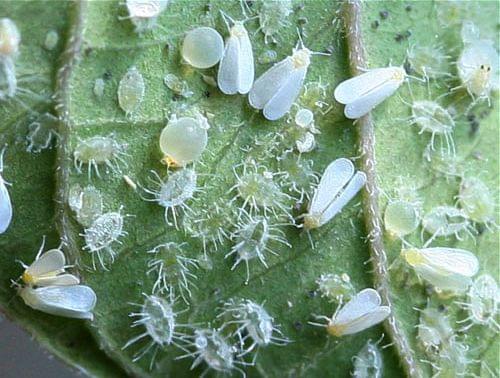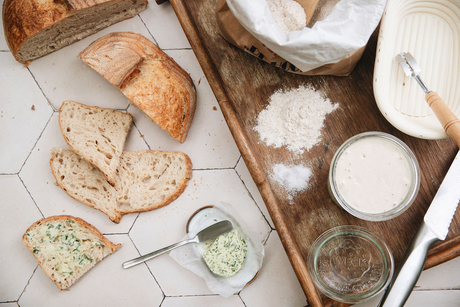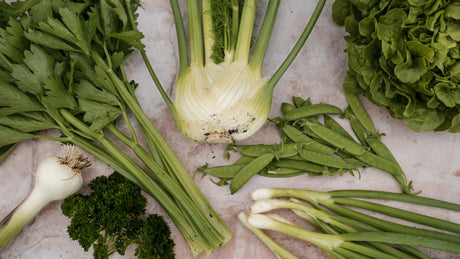Combating whitefly on your vegetable garden plants
Introduction to whitefly
They are small and often not immediately visible on your crops. Not only houseplants suffer from it but also the various vegetables, herbs and fruits in your vegetable garden. In this article you will learn more about this creature and hopefully you will find a suitable remedy so that all the goodies from your plant go to your vegetables and not to the whitefly. Whitefly
WhiteflyWhat is whitefly?
Whiteflies are winged, soft-bodied insects closely related to aphids and mealybugs. Despite what their name suggests, and these crawling creatures do have wings and can fly, they are not a true species of fly. Like aphids, whiteflies are sucking insects, which in turn produce a sticky substance known as honeydew. Honeydew can cause fungal diseases, such as sooty mold, on the leaves. Honeydew is a sign that the whitefly has been feeding for several days. You may also see ants, which are attracted to the sweet honeydew. Because the whitefly sucks a lot of sap from your plants, the plants become weak very quickly and can no longer perform photosynthesis. The leaves wilt, turn pale or yellow, growth is stunted and eventually the leaves can shrivel and fall off the plant.Where does whitefly occur?
Because whiteflies cannot survive outdoors during the winter, they often sit on houseplants or in greenhouses or garden houses. If you buy infected outdoor plants from growers or garden centres, whiteflies can become a plague in your vegetable garden. The vegetable garden plants from our webshop are subjected to an extensive check, so you can be sure that you are not bringing diseased plants into your home. The period in which you can struggle with whitefly in your vegetable garden is often from July to October and especially when it gets warm and humid.Which vegetable garden plants are susceptible to whitefly?
Whiteflies are found on a wide range of garden plants, from ornamental flowers to heat-loving crops including tomatoes , eggplants , peppers and cucumbers . Some species also attack sweet potatoes and cabbage crops. Indoors, they feed on most houseplants, preferring those with soft, smooth leaves.Identifying Whitefly
How do you recognize whitefly?
Whiteflies are quite small creatures, they grow to about 2 to 4 mm. They are somewhat triangular in shape and are often found in clusters on the underside of your leaves. They are active during the day and will fly up in fright when they feel disturbed. This makes them easier to detect than some nocturnal insect pests. There are hundreds of species of whiteflies. However, there are only a few species that are problematic in your vegetable garden. These whiteflies include the greenhouse whitefly, the band-winged whitefly, the giant whitefly and the silverleaf whitefly. White fly on bottom of leaf
White fly on bottom of leaf
Where do you find whiteflies on your plants?
Whiteflies prefer to feed on food from the growing point of your plant, so be sure to check around newly unfolded leaves. Whitefly on cabbage plant
Check the underside of the leaves, especially around the veins, for white insects, even if they are not immediately visible. Feel the surface of the leaf for sticky honeydew. If the whiteflies are feeding, they will suddenly all fly away from the leaves in a swarm, so you cannot miss them.
You can also find eggs on the underside of leaves. This is the beginning of a new generation! When the eggs hatch, the larvae look like small white balls without legs; they do not move, but immediately begin to suck plant sap. This is why gardeners often overlook whiteflies until it is too late. Adult females can produce up to 400 eggs that hatch about a week to a month after being laid. They are usually laid in a circular pattern. The eggs are light yellow when newly laid and brown when they are about to hatch.
Whitefly on cabbage plant
Check the underside of the leaves, especially around the veins, for white insects, even if they are not immediately visible. Feel the surface of the leaf for sticky honeydew. If the whiteflies are feeding, they will suddenly all fly away from the leaves in a swarm, so you cannot miss them.
You can also find eggs on the underside of leaves. This is the beginning of a new generation! When the eggs hatch, the larvae look like small white balls without legs; they do not move, but immediately begin to suck plant sap. This is why gardeners often overlook whiteflies until it is too late. Adult females can produce up to 400 eggs that hatch about a week to a month after being laid. They are usually laid in a circular pattern. The eggs are light yellow when newly laid and brown when they are about to hatch.
Prevention and treatment of whitefly
How to prevent whitefly?
Biodiversity and natural enemies
Focus on biodiversity , grow as many different types of vegetables as possible in your vegetable garden. By applyingcrop rotation you prevent soil fatigue in your vegetable garden, your plants are stronger and on the other hand you attract various useful insects that in turn can be natural enemies of possible pests. This can be done by, for example, providing more flowers in your vegetable garden. Keeping natural enemies nearby will help prevent the whitefly population from exploding. Avoid using insecticides. Parasitic wasps , ladybugs , spiders, green lacewing larvae, and dragonflies are some of the many beneficial insects that can keep a whitefly population under control.Companion planting
In addition to crop rotation, you can also use companion planting ( good neighbors ). By combining many crops with different shapes, scents and colors in your vegetable garden, you confuse the whitefly. The whitefly is, as mentioned before, a sucking insect. To know whether she has found her favorite crop, she always tastes it first. When you put different vegetable garden plants together, she often does not find her preference, which means she does not feel at home in your vegetable garden and therefore kicks it off again.Mulching
Mulch early in the season, especially around tomatoes and peppers . The mulch makes it hard for whiteflies to find their favorite crops. Mulch also helps to reduce the number of unwanted weeds and keeps the soil from drying out as quickly. Talk about a win-win-win situation...
Mechanical aids
Use mechanical aids and observe your vegetable garden. Place yellow sticky traps, or hang them in your greenhouse or conservatory, to quickly detect the whitefly in the holes. Do this especially with tomatoes, cucumbers , peppers , sweet potatoes or cabbage crops. For whitefly, the color yellow looks like a mass of new leaves. The bugs are attracted to the cards, get stuck in the jelly, and die. If your observation shows that you are starting to suffer from a plague, you know that you need to rely more on natural enemies in the future. Try to postpone the use of chemical pesticides as long as possible. An ecological alternative is to use insect netting . Tom previously wrote an article about insect netting: using ecological crop protection in your vegetable garden . It is definitely worth reading. Nature will thank you. ladybirds Adalia 100 larvae
Combat whitefly with parasitic wasp and Encarsia 150m²
 Plants from our webshop under insect screen
Plants from our webshop under insect screen
How to control whitefly?
When you use mechanical aids, you catch two (white)flies in one go. On the one hand, your sticky trap serves 2 systems: an observation system (prevention) but also as a trapping system . Sticky traps only work on adult insects, to combat the eggs and larvae you have to use beneficial insects. To prevent your beneficial insects from flying against your sticky traps, either hang them high above your plants or remove them after observation. To combat whitefly, there are several solutions you can use. The most important tip is (as with all pests): start early in your vegetable garden year! Check the back of the leaves for eggs in the morning and evening and see if the little bugs "fly away" when you get closer to your plants or when you tap your plants. Always start by spraying away whiteflies (as well as aphids and many other insect pests) with a garden hose or a plant sprayer . This will force them to spread and will to some extent drive away eggs and larvae.Insecticides: a last resort in controlling whitefly
For a large infestation, consider spraying the leaves of your plants with an insecticidal soap, following the directions on the package. Spray the undersides of the leaves as well. Do this 2 or 3 times, if necessary. Spray only in cooler temperatures, late in the day is the best time. It is easy to make a homemade mixture that is useful for controlling and deterring whiteflies. Use a mixture of dish soap and water. A good squirt of soap to a quart of water should do the trick. Whiteflies are nearly impossible to get rid of, so it is best to try more preventative tactics first, as mentioned above. When all preventive tips and mechanical aids have failed, an insecticide can be a last resort. Always take bees, bumblebees and other beneficial insects into account and do not use insecticides on plants in bloom, so that bees and bumblebees do not come into direct contact with the product. Use crop protection products safely. Read the label and product information before use. Edialux BIO Pyretrex Garden
Finally
As we always try to strive for, a vegetable garden rich in biodiversity is the best remedy against harmful insects such as whitefly. Certain plants or shrubs attract ladybirds such as garlic, parsley, marigolds , coriander, dill , marigold , alyssum or snow blanket, parsley, dandelions, butterfly bush, ... So try not only to grow crops to eat but also think of plants that attract various beneficial insects.
I hope you found this article useful. If you find the information from Moestuinweetjes valuable, then definitely consider buying your vegetable garden supplies in our webshop . For your first purchase, you can use the discount code biomoestuin for a 5 euro discount on your shopping cart. We also reward returning customers with a discount code moestuinspullen , which gives a 5 euro discount at checkout for a purchase of more than 50 euros.
Good luck in your vegetable garden,
Sarah
Edialux BIO Pyretrex Garden
Finally
As we always try to strive for, a vegetable garden rich in biodiversity is the best remedy against harmful insects such as whitefly. Certain plants or shrubs attract ladybirds such as garlic, parsley, marigolds , coriander, dill , marigold , alyssum or snow blanket, parsley, dandelions, butterfly bush, ... So try not only to grow crops to eat but also think of plants that attract various beneficial insects.
I hope you found this article useful. If you find the information from Moestuinweetjes valuable, then definitely consider buying your vegetable garden supplies in our webshop . For your first purchase, you can use the discount code biomoestuin for a 5 euro discount on your shopping cart. We also reward returning customers with a discount code moestuinspullen , which gives a 5 euro discount at checkout for a purchase of more than 50 euros.
Good luck in your vegetable garden,
Sarah









